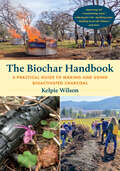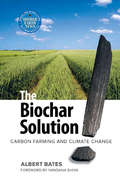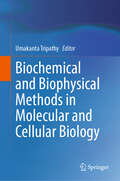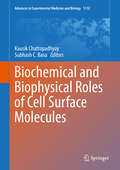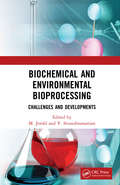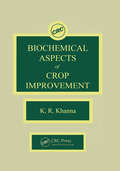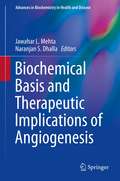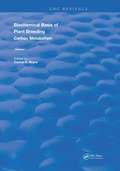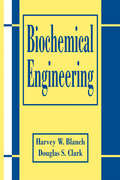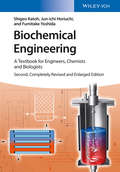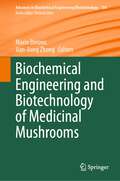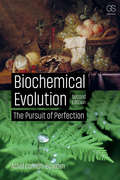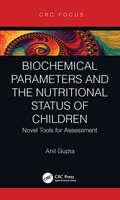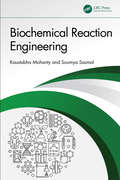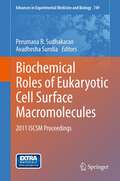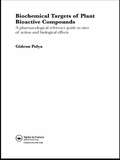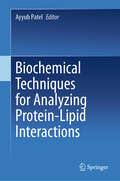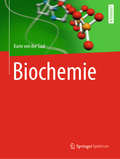- Table View
- List View
The Biochar Handbook: A Practical Guide to Making and Using Bioactivated Charcoal
by null Kelpie WilsonWith extensive research, real-world examples, and hands-on applications, this go-to guide offers a comprehensive look at the principles and practices of biochar—and all of its world-changing uses.Like many human discoveries, biochar has likely been invented, lost, and reinvented multiple times. It can be found in the rich terra preta soils of the Amazon and in the ancient &“dark earths&” dotting Africa, Asia, and Europe. However, biochar isn&’t just an archeological curiosity. In The Biochar Handbook, author Kelpie Wilson argues that the simple process of burning organic material in a low-oxygen, low-emission environment could be one of the most powerful tools we have to restore degraded soils and reduce our dependence on fossil fuels.In accessible and authoritative prose, Wilson demonstrates that biochar is a low-tech but effective means of reducing wildfire risks, restoring soil carbon, managing manure, weaning farms off of toxic inputs, and producing the best compost ever made.In this book, you&’ll also find:A pocket history of biocharStep-by-step instructions on making biochar for yourselfApplications for soil water retention, pest deterrence, compost enhancement, and moreInspiring examples of ecosystem restoration and improved forest managementLow-cost recipes, including Cultured Biochar and Sustainable Potting SoilWilson makes a compelling case that biochar is both simple to make and a potent solution to a host of knotty problems, both global and close to home. Whether you&’re a gardener, homesteader, rancher, commercial farmer, permaculturalist, or forest manager, this book will show you how to put biochar to work, making you and your community more resilient as a result.
The Biochar Solution
by Albert BatesConventional agriculture destroys our soils, pollutes our water, and is a major contributor to climate change. What if our agricultural practices could stabilize, or even reverse these trends?The Biochar Solution explores the dual function of biochar as a carbon-negative energy source and a potent soil-builder. Created by burning biomass in the absence of oxygen, this material has the unique ability to hold carbon back from the atmosphere while simultaneously enhancing soil fertility. Albert Bates traces the evolution of this extraordinary substance, from the ancient black soils of the Amazon to its reappearance as a modern carbon sequestration strategy.Combining practical techniques for the production and use of biochar with an overview of the development and future of carbon farming, The Biochar Solution describes how a new agricultural revolution can reduce net greenhouse gas emissions to below zero while increasing world food reserves and creating energy from biomass wastes. Biochar and carbon farming can:*Reduce fossil fuels inputs into our food system*Bring new life to desert landscapes*Filter and purify drinking water*Help build carbon-negative homes, communities, and nationsBiochar is not without dangers if unregulated, and it is not a panacea, but if it fulfills its promise of taking us back from the brink of irreversible climate change, it may well be the most important discovery in human history.
Biochemical and Biophysical Methods in Molecular and Cellular Biology
by Umakanta TripathyThis book focuses on the fundamental principles and applications of several modern biochemical and biophysical techniques employed in molecular and cellular biology. It describes cutting-edge techniques for studying single molecules/biomolecules, subcellular structures, and cells. The book chapters provide an in-depth understanding of methods currently employed to visualize and probe molecular and cellular processes. The techniques discussed in this book include Mass spectrometry, Microscopy techniques, Forster resonance energy transfer (FRET), Z-scan, Fluorescence correlation and cross-correlation spectroscopy, Dynamic light scattering (DLS), X-ray crystallography, Total internal reflection fluorescence (TIRF) microscopy, Cryo-EM, NMR spectroscopy, Optical tweezers, Magnetic tweezers, Raman spectroscopy, Atomic force microscopy (AFM), Optogenetics, bioinformatics, etc. The book chapters also include the biomedical, industrial, and R&D applications of these methods. Also included are sections on data analysis and its interpretation. Overall, this book offers a comprehensive and detailed understanding of several modern techniques in molecular and cellular biology.
Biochemical and Biophysical Roles of Cell Surface Molecules (Advances in Experimental Medicine and Biology #1112)
by Kausik Chattopadhyay Subhash C. BasuCell surface small molecules and macromolecules, such as members of cholesterol family (including steroid hormones), the glycolipid family (sphingolipids), the glycoprotein family (both N-linked and O-linked), and a vast array of other receptors have been shown to be involved in normal and abnormal cellular processes. The 11th International Symposium on Cell Surface Macromolecules, held in Mohali, India, in February 2017 provided a comprehensive update on the major advances in this area. Presenting selected contributions from this meeting, this book comprises 24 chapters, which provide in-depth analyses of data on the role of cell surface macromolecules in cellular function and their alterations associated with pathological conditions. It includes comprehensive research papers and critical overviews of the functional role of cell surface molecules, discussing topics such as biochemical, biophysical, and cell biological approaches to study cell membrane molecules, and metabolism of glycoconjugates.
Biochemical and Environmental Bioprocessing: Challenges and Developments
by M. Jerold V. SivasubramanianThe rapid growth of industries has resulted in the generation of high volume of solid and liquid waste. Today, there is a need of Clean and Green technology for the sustainable waste management. Biochemical and Environmental Bioprocessing: Challenges and Developments explore the State-of-art green technologies to manage the waste and to recover value added products. Microbes play an important role in the bioremediation. Bioprocess engineering an interdisciplinary connects the Science and Technology. The bioconversion and bioremediation is essentially required for the management of various hazardous substances in the environment. This book will give an intensive knowledge on the application of Biochemical and Bioprocess technologies for the eco-friendly management of pollution. This book serves as a fundamental to the students, researchers, academicians and Engineers working in the area of Environmental Bioremediation and in the exploration of various bioproducts from waste. Features Reviews various biological methods for the treatment of effluents from Industries by using biomass and biopolymers. Highlights the applications of various bioreactors like Anaerobic Sequential Batch Reactor, Continuously stirred anaerobic digester, Up-flow anaerobic sludge blanket reactor, Fluidized and expanded bed reactors. Presents the cultivation of algae in Open Pond, Closed loop System, and Photo-bioreactors for bioenergy production. Discusses the intensified and integrated biorefinery approach by Microwave Irradiation, Pyrolysis, Acoustic cavitation, Hydrodynamic cavitation, Electron beam irradiation, High pressure Autoclave reactor, Steam explosion and photochemical oxidation. Outlines the usage of microbial fuel cell (MFC) for the production bioelectricity generation in different modules Tubular MFC, Stacked MFC, Separate electrode modules Cutting edge research of synthesis of biogenic nanoparticles and Pigments by green route for the health care and environment management.
Biochemical Applications of Nonlinear Optical Spectroscopy (Optical Science and Engineering)
by Vladislav V. YakovlevFor a host of reasons, nonlinear optical spectroscopy is a valuable tool for biochemical applications where minimally invasive diagnostics is desired. Biochemical Applications of Nonlinear Optical Spectroscopy presents the latest technological advances and offers a perspective on future directions in this important field.Written by an international panel of experts, this volume begins with a comparison of nonlinear optical spectroscopy and x-ray crystallography. The text examines the use of multiphoton fluorescence to study chemical phenomena in the skin, the use of nonlinear optics to enhance traditional optical spectroscopy, and the multimodal approach, which incorporates several spectroscopic techniques in one instrument. Later chapters explore Raman microscopy, third-harmonic generation microscopy, and non-linear Raman microspectroscopy. The text explores the promise of beam shaping and the use of broadband laser pulse generated through continuum generation and an optical pulse shaper.Lastly, the book discusses the effects of spatial beam shaping on the generated nonlinear Raman signals in a tightly focused geometry and provides insight into the extension of nonlinear optical spectroscopy to the nanoscale through the use of plasmonic tip-enhanced arrangement. With novel experimental approaches to this technology expanding day-by-day, the book’s balanced coverage from a wide range of international contributors not only elucidates important achievements, but also outlines future directions in this dynamic and promising field.
Biochemical Aspects of Crop Improvement
by K. R. KhannaThis book provides a comprehensive review at the biochemical and molecular level of the processes and techniques that contribute to crop improvement. General topics include a historical perspective of the advancements in crop improvement; cultivar systematics and biochemical and molecular markers in crop improvement programs; the genetics of physiological and biochemical processes affecting crop yield; the genetics of photosynthesis, chloroplast, relevant enzymes, and mutations; osmoregulation/adjustment and the production of protective compounds in relation to drought tolerance; and the biochemistry of disease resistance, including elicitors, defense response genes, their role in the production of phytoalexins and other strategies against pathogens. Other topics include quality breeding (e.g., molecular gene structure, changing individual amino acids, enhancing nutritive value of proteins) and biotechnology/genetic engineering. Geneticists, biochemists, botanists, agricultural specialists and others involved in crop improvement and breeding should consider this volume essential reading.
Biochemical Basis and Therapeutic Implications of Angiogenesis (Advances in Biochemistry in Health and Disease #6)
by Naranjan S. Dhalla Jawahar L. MehtaAngiogenesis is a highly complex phenomenon where new blood vessels are formed for the supply of oxygen and nutrients in different organs of the body. It plays a critical role in both physiological processes such as growth and development as well as pathological processes including cancer and different types of tumors. Angiogenesis is also essential for the regeneration and survival of cells in several disease conditions such as ischemic heart disease (myocardial infarction), atherosclerosis, brain injury (stroke) and diabetes. Since the mechanisms of angiogenesis are organ specific and differ among various diseases, it is proposed to devote one section of this book to the development of angiogenesis in some selected diseases such as cancer, ischemic heart disease, atherosclerosis, diabetes and stroke. It is pointed out that extensive research work in this regard has been carried out in the area of cancer and heart disease, whereas relatively less attention has been paid to studying angiogenesis in other disease conditions.
Biochemical Basis of Plant Breeding: Volume 1 Carbon Metabolism (Routledge Revivals)
by Carlos A. NeyraFirst published in 1985: This book presents a comprehensive survey of progress and current knowledge of those biochemical processes with greater potential for the development of superior cultivars: Photosynthesis, photorespiration, nitrate assimilation, biological nitrogen fixation, and starch and protein synthesis.
Biochemical Engineering
by Douglas S. Clark Harvey W. BlanchThis work provides comprehensive coverage of modern biochemical engineering, detailing the basic concepts underlying the behaviour of bioprocesses as well as advances in bioprocess and biochemical engineering science. It includes discussions of topics such as enzyme kinetics and biocatalysis, microbial growth and product formation, bioreactor design, transport in bioreactors, bioproduct recovery and bioprocess economics and design. A solutions manual is available to instructors only.
Biochemical Engineering
by Shigeo Katoh Fumitake Yoshida Jun-Ichi HoriuchiCompletely revised, updated, and enlarged, this second edition now contains a subchapter on biorecognition assays, plus a chapter on bioprocess control added by the new co-author Jun-ichi Horiuchi, who is one of the leading experts in the field. The central theme of the textbook remains the application of chemical engineering principles to biological processes in general, demonstrating how a chemical engineer would address and solve problems. To create a logical and clear structure, the book is divided into three parts. The first deals with the basic concepts and principles of chemical engineering and can be read by those students with no prior knowledge of chemical engineering. The second part focuses on process aspects, such as heat and mass transfer, bioreactors, and separation methods. Finally, the third section describes practical aspects, including medical device production, downstream operations, and fermenter engineering. More than 40 exemplary solved exercises facilitate understanding of the complex engineering background, while self-study is supported by the inclusion of over 80 exercises at the end of each chapter, which are supplemented by the corresponding solutions. An excellent, comprehensive introduction to the principles of biochemical engineering.
Biochemical Engineering and Biotechnology of Medicinal Mushrooms (Advances in Biochemical Engineering/Biotechnology #184)
by Marin Berovic Jian-Jiang ZhongThis book offers a comprehensive review of the latest developments in medicinal mushroom biochemical engineering and biotechnology, and it also analyses the circular economy of mushroom bioproduction. Divided into 13 chapters, the book begins with a historical perspective of medicinal mushrooms, followed by authoritative chapters that explore the farming of medicinal mushrooms and bioeconomy, as well as the limitations of using medicinal mushrooms to produce metabolites. Subsequent chapters cover topics such as solid-state and submerged cultivation of medicinal mushroom mycelia in bioreactors, pilot and industrial bioreactor cultivation experiences, downstream processing of medicinal mushroom products, and biochemistry of medicinal mushroom bioactive compounds. Particular attention is given to the recent genetic engineering techniques applied in mushroom cultivation. The book closes with a chapter devoted to the health and clinical benefits of medicinal fungi, where readers will find expert insights into the therapeutic implications of medicinal fungi. In this book, readers will find an authoritative perspective on the past, present and future of medicinal mushrooms, and will also learn about some recent clinical studies with isolates from these natural products. Given its breadth, this book will appeal to biotechnologists working in mushroom cultivation, as well as to professionals interested in traditional pharmacy and medicine.
Biochemical Evolution: The Pursuit of Perfection
by Athel Cornish-BowdenBiochemical Evolution: The Pursuit of Perfection, Second Edition describes the relationship between biochemistry and evolutionary biology, arguing that each depends on the other to be properly understood.
Biochemical, Immunological and Epidemiological Analysis of Parasitic Diseases
by P.K. Bandyopadhyay N.R. Das Amit ChattopadhyayThis book comprehensively reviews various vector-borne diseases and their control methods. It discusses morphology, life history, and pathogenicity of protozoan and helminth parasites. Further, it analyzes host-parasite interactions and their adaptation within the host system for understanding parasitic infections. The book discusses the complex life cycle, biochemical adaptations, and molecular biology of the parasites. It investigates the immunological response to different infectious agents and explores new targets for combined therapeutic approaches. It also summarizes the evolution of parasitism and the ecology of parasites of the different phylum. Lastly, it provides information on vector biology emphasizing the role of basic vector research in developing future disease control methods and improving upon the existing approaches.
Biochemical Mechanisms for Metabolic Syndrome (Advances in Biochemistry in Health and Disease #31)
by Tejal Gandhi Anita MehtaThe book "Biochemical Mechanisms for Metabolic Syndrome" delves into the intricate biochemistry underlying the complex condition known as Metabolic Syndrome. The main focus of the book is to provide a comprehensive overview and in-depth exploration of the various biochemical processes and molecular mechanisms contributing to the development and progression of Metabolic Syndrome. The book is structured into several chapters, each with a specific purpose. The initial chapters, lay the groundwork by introducing the concept of Metabolic Syndrome, its historical context, prevalence, and the risk factors associated with it. Subsequent chapters tackle various aspects of insulin resistance and its underlying mechanisms, lipid metabolism dysregulation, the impact of obesity, and the complex interplay between Metabolic Syndrome and hypertension. The book then shifts focus to exploring the genetic predisposition to Metabolic Syndrome and delves into recently explored indepth cellular and tissue mechanisms, including the role of gut barrier dysfunction and adipose tissue remodeling. Chapters dedicated to molecular mechanisms and signaling pathways offer a deeper understanding of the inflammatory resolution, and endoplasmic reticulum stress in the context of Metabolic Syndrome. Another significant aspect of the book is the exploration of the Brain-Gut-Adipose Axis and endocrine regulation, looking at the impact of gut microbiota-derived metabolites, gut hormones, and neuronal regulation on Metabolic Syndrome. Additionally, omics technologies are covered extensively, ranging from genomics, transcriptomics, proteomics, and epigenomics, to unravel the molecular complexity of Metabolic Syndrome. The latter part of the book delves into therapeutic approaches, including lifestyle interventions, pharmacological interventions, and dietary strategies. It also explores the therapeutic potential of brown adipose tissue, and highlights future directions and emerging research in the field of Metabolic Syndrome biochemistry. Overall, the book will provide a valuable resource for researchers, healthcare professionals, and students seeking a comprehensive understanding of the biochemical intricacies of Metabolic Syndrome and potential avenues for therapeutic interventions.
Biochemical Parameters and the Nutritional Status of Children: Novel Tools for Assessment
by Anil GuptaBiochemical parameters represent better, precise, and objective tools toward the assessment of the nutritional status of children in comparison to anthropometric, clinical, and dietary methods. They constitute laboratory tests to estimate the concentration of circulating nutrients in body fluids. Biochemical parameters are suggestive of acute or subclinical conditions when other methods of nutritional assessment fail to interpret the condition. These parameters exhibit substantial variability in their reproducibility. Moreover, these parameters are novel tools in the hands of clinicians for screening of the nutritional status of children. Key Features Covers the latest biochemical parameters for nutritional assessment Updated content is useful for clinicians, nutritionists, and general practitioners A unique and concise treatise covering descriptive and research-based work on a crucial health issue of worldwide prevalence About the Author Anil Gupta, PhD, is the Dean of Research at Desh Bhagat University and Professor and Head, Department of Physiology and Biochemistry at Desh Bhagat Dental College and Hospital, Mandi Gobindgarh, Punjab, India.
Biochemical Pathways
by Dietmar Schomburg Gerhard MichalThe pathways and networks underlying biological functionNow in its second edition, Biochemical Pathways continues to garner praise from students, instructors, and researchers for its clear, full-color illustrations of the pathways and networks that determine biological function.Biochemical Pathways examines the biochemistry of bacteria, plants, and animals. It offers a quick overview of the metabolic sequences in biochemical pathways, the chemistry and enzymology of conversions, the regulation of turnover, the expression of genes, the immunological interactions, and the metabolic background of health disorders. A standard set of conventions is used in all illustrations, enabling readers to easily gather information and compare the key elements of different biochemical pathways. For both quick and in-depth understanding, the book uses a combination of:Illustrations integrating many different features of the reactions and their interrelationshipsTables listing the important system components and their functionText supplementing and expanding on the illustrated factsIn the second edition, the volume has been expanded by 50 percent. Text and figures have undergone a thorough revision and update, reflecting the tremendous progress in biochemical knowledge in recent years. A guide to the relevant biochemical databases facilitates access to the extensive documentation of scientific knowledge.Biochemical Pathways, Second Edition is recommended for all students and researchers in such fields as biochemistry, molecular biology, medicine, organic chemistry, and pharmacology. The book's illustrated pathways aids the reader in understanding the complex set of biochemical reactions that occur in biological systems.From the reviews:"... highly recommended for every scientist and student working in biochemistry." -Umwelt & Gesundheit 4/2012 (review in German language)
Biochemical Pharmacology
by Michael Palmer Alice Chan Thorsten Dieckmann John HonekAn integrated approach to the study of drug action mechanisms Biochemical Pharmacology is a concise and contemporary textbook on the principles of drug action. It discusses representative drugs by example to explore the range of biochemical targets and mechanisms. The book explains some of the experiments that tell us how drugs work, and it outlines the physiological and pathological context that make those action mechanisms therapeutically useful. Biochemical Pharmacology is intended primarily for students in biology and biochemistry at the advanced undergraduate or graduate levels. For classroom use, the illustrations from the book are separately available as PowerPoint slides. It is written in a conversational, vivid style that readily encourages students to explore this important area of medical science. Biochemical Pharmacology can also serve as an introduction for professionals in biosciences, as well as in pharmaceutical and health sciences. Complete with numerous figures throughout the text, which are also available separately as PowerPoint slides, Biochemical Pharmacology: Explains the role of pharmacodynamics, pharmacokinetics, and drug metabolism in drug action Provides representative examples from the pharmacology of cell excitation, hormones, nitric oxide, chemotherapy, and others Examines emerging applications of ribonucleic acids as drugs and drug targets Discusses what researchers need to know about the problems of drug distribution, elimination, and toxicity Biochemical Pharmacology is an important resource for anyone wishing to gain an in-depth understanding of drug action mechanisms and extremely useful for researchers wishing to explore some of the unanswered questions .
Biochemical Reaction Engineering
by Kaustubha Mohanty Soumya SasmalThis textbook comprehensively covers fundamental and advanced aspects of biochemical engineering along with MATLAB codes. It comprehensively covers important topics including enzyme catalyzed reaction kinetics, catalytic antibodies and non-protein biomolecules as catalysts, process flow diagram (PFD), piping & instrumentation diagram (P&ID), wastewater treatment processes, design of fermenters and mass and energy balance. Pedagogical features including solved problems and unsolved exercises are interspersed throughout the text for better understanding.This book: Provides solid foundation and understanding of the fundamental principles of mathematics, science, and engineering Explores tools for solving theoretical and open-ended biochemical engineering problems Covers principles of downstream process and biochemical engineering principles with illustration and problems Discusses application of computer and programming in biochemical engineering Covers case studies for bioprocess plant design. The textbook is primarily written for senior undergraduate and graduate students in the fields of chemical engineering, biotechnology, and food process engineering for courses on biochemical engineering/bioprocess engineering/downstream processing.
Biochemical Roles of Eukaryotic Cell Surface Macromolecules: 2011 Iscsm Proceedings (Advances in Experimental Medicine and Biology #842)
by Avadhesha Surolia Abhijit ChakrabartiConsists of critical reviews and original research papers from the 2014 International Symposium on the "Biochemical Role of Eukaryotic Cell Surface Macromolecules". Topics covered include: · neurochemical and biochemical analysis of cell surface glycoconjugates · membrane skeletal organization · GPCRs and other receptors · biophysical approaches to study membrane interactions · glycoconjugate metabolism · dysregulation · molecular mechanisms involved in cell-cell and cell-matrix interaction · glycans in infectious and neurological diseases · cancer and glycosyltransferases as drug targets.
Biochemical Roles of Eukaryotic Cell Surface Macromolecules: 2011 ISCSM Proceedings (Advances in Experimental Medicine and Biology #842)
by Avadhesha Surolia Perumana R. SudhakaranCell surface molecules are critically important in regulating cell structure and function. Recent advances on the functional role of cell surface molecules, particularly glycoconjugates are presented in this book. Comprising of 22 chapters from the 2011 International Symposium on Biochemical Roles of Eukaryotic Cell Surface Macromolecules, it covers topics on the analysis of glycome, biophysical approaches to study cell surface molecules, glycoconjugate metabolism and its dysregulation, and molecular mechanisms involved in cell-cell and cell-matrix interaction.
Biochemical Targets of Plant Bioactive Compounds: A Pharmacological Reference Guide to Sites of Action and Biological Effects
by Gideon PolyaWhen introduced to the human body, bioactive metabolites produced by plants for self defense bind to particular biochemical targets, most notably to proteins involved in signaling by hormones and neurotransmitters. This, essentially, is the basis for the effects of herbal medicine. While herbal medicine preparations may act by complex synergistic i
Biochemical Techniques for Analyzing Protein-Lipid Interactions
by Ayyub PatelThe book reviews cutting-edge advancements and their implications across various domains of molecular diagnostics. It covers foundational topics like protein-ligand interactions, lipid-protein interactions within biological membranes, and the application of NMR spectroscopy in understanding membrane structures. The book also explores advanced techniques such as X-ray crystallography, liposome microarray assays, and protein-lipid interaction studies. By integrating experimental and computational methods, it provides a comprehensive guide to understanding the complexities of molecular diagnostics, from basic principles to innovative approaches in drug discovery and therapeutic development. Each chapter offers detailed discussions on specific topics, supported by experimental data and methodological insights, making it an invaluable resource for researchers, clinicians, and students seeking to enhance their knowledge and expertise in molecular diagnostics.
Biochemie
by Karin von der SaalVerständlich und kompakt, gibt Ihnen dieses kurze Lehrbuch einen Überblick zu den wichtigsten Themen der Biochemie. Dabei lernen Sie die großen Zusammenhänge kennen, gewinnen aber auch interessante Einblicke, zum Beispiel zu Ernährungs- und medizinischen Themen, die den Stoff in einen breiteren Zusammenhang stellen. Dieses Buch ist für Sie richtig, wenn Sie Biochemie studieren und sich auf die Bachelor-Prüfung vorbereiten; Sie bekommen hier ein Repetitorium in die Hand. andere naturwissenschaftliche Fächer studieren oder Quereinsteiger sind; Sie erhalten hier einen Einblick in die Biochemie.Laborant/in, Techniker/in oder Ingenieur/in sind, Ihr Wissen auffrischen möchten oder Grundkenntnisse der Biochemie für ihren Beruf benötigen. Mit umfangreichen Querbezügen zum beliebtesten großen Biochemie-Lehrbuch, dem „Stryer“, können Sie den hier dargestellten Stoff bei Bedarf sofort vertiefen.
Biochemie - Energiestoffwechsel
by Freya HarmjanzWenn Sie die Biochemie im Großen und Ganzen verstehen wollen, ohne Unmengen von Details auswendig zu lernen, sind Sie hier richtig. In diesem Buch beginnt jedes Kapitel mit einer verständlichen Abbildung für den Überblick, bevor es in die Tiefe geht. So laufen Sie nicht Gefahr, den Überblick zu verlieren.Bei der Erklärung der vielen Moleküle werden die Zusammenhänge innerhalt der Biochemie dargestellt und dabei die drei wichtigen Fragen beantwortet:· Woher kommt das Molekül?· Was macht es hier?· Wo geht es danach hin?Und für die Klinik gibt es Antwort auf die spannende Frage:· Was passiert eigentlich, wenn hier was schief geht?Da die Semesterklausuren häufig schwieriger sind als das Examen, legt das Buch seinen Schwerpunkt auf die Klausuren. So sind Sie für alle Fälle gut gerüstet. Und damit die Biochemie handlich bleibt, ist der Stoff auf drei Bände verteilt:Band 1 Zelle, Enzyme und praktische BiochemieBand 2 EnergiestoffwechselBand 3 Regulation, Blut, Krankheitserreger
